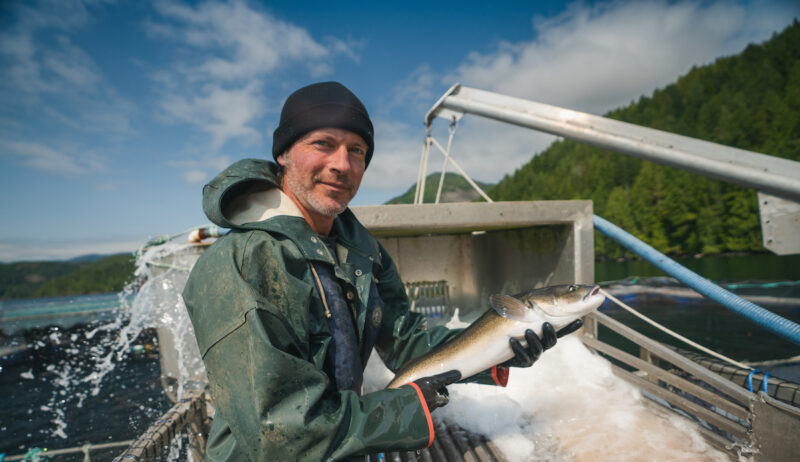Just how opposed are First Nations to open-net aquaculture in BC ?
We Wai Kai First Nation, said to be opposed to open-net aquaculture, gets tax-dollars to investigate sablefish farming in BC oceans
By Fabian Dawson
SeaWestNews
Canada’s Fisheries Minister Bernadette Jordan has been saying the decision to oust fish farmers in British Columbia’s Discovery Islands is because First Nations in the area oppose open-net pen aquaculture operations in their traditional territories.
A government funding announcement this week seems to contradict that.
One of the seven First Nations which was consulted in the Discovery Islands decision making process – We Wai Kai – has been given $144,200 in government funding to explore the possible environmental impacts and determine the potential business benefits of sablefish aquaculture.
This is for a potential joint venture partnership with Golden Eagle Sablefish, which operates the only commercial scale ocean-pen sablefish farm in the world, in Kyuquot Sound off Vancouver Island.
The envisioned sablefish operation is ocean-based because growing this prized buttery fish to market size on land, is cost and energy prohibitive.
Sablefish, also known as Black Cod or Butterfish, is a highly migratory ancient species, that has been commercially fished for over 40 years in British Columbia and Alaska.
Golden Eagle, which produced about 450,000 ‘Gindara’ sablefish last year from its world renowned operations credits the BC salmon farming industry for its success.
The Aboriginal Aquaculture Association (AAA) based in Campbell River states that after 30 years of research, sablefish is a priority candidate for commercial cultivation in B.C.
“Some estimates suggest that an operation with 150,000 sablefish/year in annual production would employ five people directly, and support another five fulltime equivalent (FTE) jobs in harvesting, processing, transportation, net lofts etc., generating revenue of some $7.0 million at today’s prices, the group states on its website.
“A potential opportunity also exists where First Nations could work with B.C. salmon farming companies to set up (sablefish) production at existing, idle farms, using surplus equipment,” said the AAA.
Another First Nations group, The Gwabalis Fisheries Society, some of whose members are also said to oppose open-net fish farming, was given $107,167 to undertake an area-wide aquaculture survey to identify, assess and report on sustainable aquaculture opportunities within the member Nations’ respective traditional territories.
The survey will look at and collect data from areas likely to support aquaculture, based on environmental and ecological criteria as well as site accessibility, risks, and benefits.
“First of all congratulations to the First Nations whose proposed projects will continue to prove that wild and farmed fish will create a shared prosperity for them and the coastal communities of Vancouver Island,” said a veteran salmon farmer in BC.
“But the question remains as to why would the Minister say a First Nation is opposed to open net fish farms in their traditional territory and then give them tax dollars to study what they are opposed to… it begs the question as to just how opposed are the First Nations to marine aquaculture,” he said.
“While there some differences in growing salmon and growing sablefish, the fundamentals are the same…you grow them in land-based hatcheries and transfer the fish to ocean pens to grow to market size
“It’s perplexing, like all the other recent decisions by the minister involving the future of aquaculture in BC,” he said.
The We Wai Kai did not respond to questions from SeaWestNews.
Both the Federal Government and the Provincial Government parroted each other with a non-response saying that the We Wai Kai’s proposal for a feasibility study was found to meet the criteria for the grants and ultimately met with approval for funding.
“It would not be appropriate to speculate further on future considerations that may come at a later date,” said DFO.
Other recipients of the $7.9 million in grants announced this week under the British Columbia Salmon Restoration and Innovation Fund (BCSRIF) are:
- The Pacific Salmon Foundation (PSF) to develop a set of Climate Action Priorities for Salmon.
- Lake Babine First Nation to collect information on the total number of sockeye harvested by sport fishermen, harvest per unit effort, and angler origins, to contribute to in-season management decisions.
- The Kingfisher Interpretive Centre Society to repair the water intake system for its hatchery in Cooke Creek, which suffered major damage in 2014, improving its efforts to enhance local Chinook salmon stocks.
- The BC Shellfish Growers’ Association to adopt innovative new shellfish processing and handling, environmental stewardship, and traceability technologies to ensure that the shellfish aquaculture industry remains a pillar of BC’s coastal communities, and
- Seed Science Ltd. to investigate a more energy-efficient method to produce higher-quality algae as food for cultured bivalves.
Some 48 projects have received BCSRIF funding since the program’s inception in 2019, representing an investment of more than $75 million for the future of wild Pacific salmon and the BC fish and seafood sector.
“Innovation is clearly at work in these projects, which showcase the tremendous contributions of British Columbians to their province’s fish and seafood industry. Investments in these projects are vital to the sustainable growth of our seafood industry and securing the future of our coastal economies,” said Terry Beech, Parliamentary Secretary to the Minister of Fisheries, Oceans, and the Canadian Coast Guard.
Image : Golden Eagle sablefish spend about 20 months growing in Kyuquot Sound in a production partnership with the Kyuquot-Checleseht First Nations

